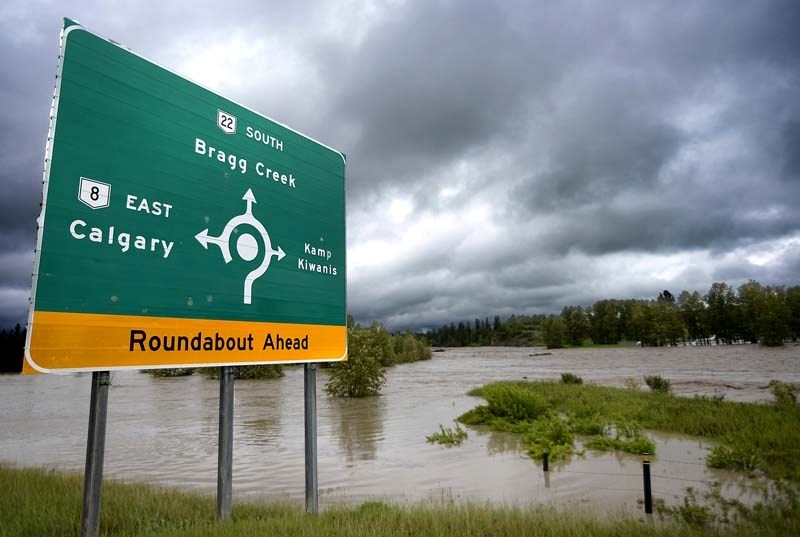The Comprehensive Flood and Water Management Council, an informal volunteer group of Calgary and area residents, are looking to get the message out to the public that there is a better alternative to the controversial Springbank Off-Stream reservoir with respect to flood mitigation.
The Springbank (dry dam) project is currently under environment impact assessment review by the provincial and federal environmental agencies.
The 2013 flood caused considerable damage to the area – including severe damage, house and business loss in the Bragg Creek area.
The Tri-River Joint Reservoir Project (TRJR), spearheaded by Dr. Emile Gabriel, is a comprehensive solution involving the four rivers that cause flooding in Alberta – the Bow, Elbow, Sheep and Highwood rivers.
Gabriel asserts that the “Elbow, Sheep and Highwood rivers can be connected to a central reservoir at the vicinity of the Sheep River” which would facilitate management of the Bow.
The project, according to Gabriel, will be the most effective alternative to “prevent floods, start up natural reservoirs and to deal with draught”.
The reservoir would have an average length of one kilometre and height of 800 metres; the length of the available area for the reservoir would be 30 km.
He said that the public is mistakenly under the impression that the Springbank solution is “better than nothing” and is hopeful that the province (which rejected his proposal last year) will revisit the TRJR, considering the recent decision to delay the Springbank dry dam project until next year, following a year-long review process.
Gabriel said his submission to Alberta Environment elicited a response from the ministry that raised five points of concern, which he said he successfully addressed in his response.
The concerns included high costs; engineering challenges posed by the proposed connector for the Sheep-Highwood channels; environmental concerns (provincial park); ineffectiveness of preventing downstream flooding if the storm occurred further south; and that the proposal may violate provincial policy with respect to inter-basin transfer.
Noelle and David Read are Calgary residents who have taken interest in flood mitigation projects. They were not personally affected by the 2013 flood but see their engagement as a personal responsibility for future generations.
They have been championing the TRJR project since meeting Gabriel at an Elbow Watershed Council AGM in June 2015.
“I just thought this is the answer to solve the (flooding) problems for the river communities,” said Noelle. “Even to someone like me, who is not an engineer, this proposal makes sense.”
The Reads are hopeful to gain the province’s attention through further public engagement. Noelle said she would like to see Alberta Environment look at conducting some environmental assessments to test the viability of the TRJR.
Up until that point, the Reads believed the (rejected) McLean Creek dam would be the most suitable option (rather than the Springbank dam).
Bragg Creek and Redwood Meadows residents would not be protected from flooding by the Springbank option, which has seen significant public pushback.
Dick Koetsier spearheaded the Don’t Dam Springbank movement. He remains firm that McLean Creek would be the best option, for reasons such as having the least environmental impact, for being a recreational asset and for providing much-needed flood mitigation for Bragg Creek and Redwood residents.
“I still think McLean would be the most effective option,” he said, adding that while he is pleased to see any alternatives to Springbank being explored, he is concerned with some technical elements and possible negative environmental impact from the TRJR project.
Gabriel highlights the advantages of the TRJR as being a comprehensive solution that deals with four rivers from one central location/redistribution reservoir; that it could help control erosion and regulate water flow rates; and that it would help transition from coal plants to clean energy, creating jobs.
Noelle and David are concerned the Springbank solution would be a failure in the event of another catastrophic event like 2013.
According to Gabriel, who presented the TRJR to the Calgary South Rotary Club Sept. 1, “the Springbank dry dam is not designed to contain a flood the size of the 2013 event, so that if the flood was as large or larger, the dam could be overcome and have no mitigative effect”.
Other points negating the Springbank option that were included in Gabriel’s presentation are that it would render 6,884 acres of agriculture lands unusable and force families off their lands (a major motivation for the Don’t Dam Springbank movement); and it is located too close to communities.
A report on the suitability of the McLean Creek and Springbank dry dam options conducted by Dutch researchers Deltares was submitted to the province last fall. The report indicated that the Springbank option would not be sufficient to mitigate a flood greater than the 2013 event.
The Springbank option was deemed favourable by the province for affordability (estimated at $250 million) and for having less environmental impact than other projects.
The 2013 flood is estimated to have cost more than $5 billion, according to the Government of Alberta. The federal government committed $2.8 billion to the province for flood mitigation.
Learn more about TRJR at http://preventingalbertafloods.ca.



